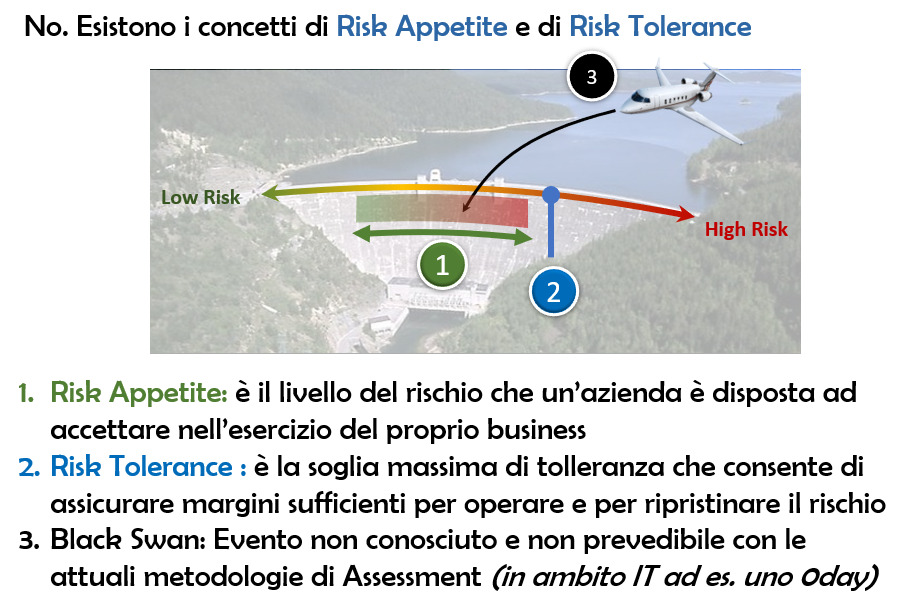
Cybersecurity is a critically important topic for companies and organizations of all sizes and industries. As business operations and information management become increasingly digital, the risk of cyberattacks has become increasingly high.
In this article, we’ll explore the concept of zero risk and why, despite efforts to reduce risk, achieving a complete, risk-free level of security is impossible.
We’ll also explore the concepts of risk appetite and risk tolerance, explaining why it’s important to understand risk and adopt strategies to manage it, rather than trying to eliminate it completely. Finally, we’ll discuss the Black Swan concept and how unpredictable events can compromise cybersecurity, even when all possible preventive measures are taken.
The concept of zero risk is often associated with cybersecurity. Many believe it’s possible to achieve a level of security that completely eliminates any risk of cyberattack. However, the reality is quite different.
First, it’s important to understand that cybersecurity is not absolute, but relative. Cybersecurity is not a fixed condition, but a continuous process of risk management. Cyber attackers are increasingly sophisticated and innovative, which means cybersecurity threats are constantly evolving. This makes it impossible to achieve a level of security that completely eliminates all risk of attack.
Second, cybersecurity involves multiple factors, including technology, people, and processes. Even if the most advanced security technologies are implemented, human vulnerabilities and inadequate processes can still make a company vulnerable to cyberattacks. For example, an employee could fall into a phishing trap and provide their login credentials to an attacker. In this case, even if the company has implemented advanced security technologies, its cybersecurity would have been compromised due to human error.
Third, the costs associated with achieving zero risk can be excessive. Managing cyber risk requires implementing security measures, which in turn require financial and human resources. Striving for zero risk can therefore become a costly and unsustainable goal for many companies.
Finally, it’s important to understand that zero risk doesn’t necessarily mean a company is safe from cyber attacks. Even if a company has achieved a level of security that makes it immune to a certain type of attack, that doesn’t mean it’s protected from other types of attacks. Cyber attackers are always looking for new ways to breach cyber security, and that means every company is always at risk.
In short, zero risk is a cybersecurity dream. Companies should instead focus on managing cyber risk and defining an acceptable level of risk based on their risk appetite and risk tolerance. This will enable them to make informed risk management decisions and invest in cybersecurity measures that are proportionate to the level of risk they are willing to bear.
The concept of risk appetite is fundamental to managing cyber risk in a company. Risk appetite is the level of risk a company is willing to tolerate to achieve its business objectives. In other words, it’s the amount of risk a company is willing to take to achieve a certain level of return.
The concept of risk appetite is important because it allows companies to define their business objectives and make informed risk management decisions. For example, a company with a high level of risk appetite might decide to invest in new technologies or riskier marketing initiatives, knowing that this could lead to greater long-term growth.

However, risk appetite should not be confused with risk tolerance. Risk tolerance is the amount of risk a company can tolerate without compromising its ability to achieve its business objectives. In other words, risk tolerance is a company’s ability to withstand a certain level of risk without suffering significant harm.
Companies must consider both risk appetite and risk tolerance when managing cyber risk. For example, if a company has a low risk appetite, it may decide to invest in cybersecurity measures to mitigate risks. However, if the cost of these measures exceeds its risk tolerance, the company may need to revise its risk management strategies.
In summary, the concept of risk appetite is fundamental to managing cyber risk in a company. Defining a risk appetite level allows companies to make informed risk management decisions and pursue their business objectives. However, it’s important for companies to also consider their risk tolerance when deciding to invest in cybersecurity measures to mitigate risks.
Knowing the risks to which a company is exposed is a fundamental step in protecting itself from cyber threats. However, eliminating risk completely is an unprofitable strategy.
There are situations in which reducing risk can lead to excessive costs or limit business efficiency. For example, it might be expensive to implement a highly advanced security solution to protect against a DDoS attack when the company has a low probability of suffering a similar attack.
Furthermore, completely eliminating risk could also prevent the company from seizing attractive business opportunities. For example, if an e-commerce company decides to suspend online sales due to the risk of DDoS attacks, it will lose a significant source of revenue.
In summary, the best approach to managing cyber risk is to assess risks, define your risk appetite, and adopt appropriate preventative measures. This means that companies must invest in cybersecurity solutions that are tailored to their needs and enable them to effectively mitigate risks.
Furthermore, it is important for companies to be aware of the risks they are exposed to and adopt safe practices, such as using strong passwords and protecting network access devices. This way, they can reduce the risk of cyberattacks and protect their online activities.
Cyberrisk management must be balanced. Investments must be focused on the most critical areas and on mitigating the highest risks, without neglecting flexibility and the ability to adapt to new threats. Furthermore, organizations must be aware of the need to maintain the right balance between cybersecurity and the ability to provide products and services to their customers.
In summary, the need to understand risk is fundamental to cybersecurity. Risk analysis is a valuable tool for better understanding cyber threats and vulnerabilities. However, organizations must adopt a cyber risk management strategy that reflects their risk appetite and risk tolerance, balancing investments to reduce risk and maintain the flexibility needed to operate in an increasingly complex environment.
The term “Black Swan” refers to an unpredictable and highly unlikely event that has significant consequences. In the context of cybersecurity, DDoS attacks could be considered Black Swan events, as they can occur unexpectedly and cause serious consequences.
It is important for companies to take preventative measures to mitigate the risks of these events, even if they are highly unlikely. This means that companies should invest in cybersecurity solutions that can protect them from these unpredictable events.
Furthermore, companies should develop contingency plans to manage cyberattacks when they do occur. This means they should have a strategy to restore online services as quickly as possible, limiting damage and resuming normal operations as quickly as possible.
Companies should define their risk appetite and invest in cybersecurity solutions that can effectively mitigate risks. They should also develop contingency plans to manage cyberattacks when they occur and protect their online activities with safe practices.
Follow us on Google News to receive daily updates on cybersecurity. Contact us if you would like to report news, insights or content for publication.
